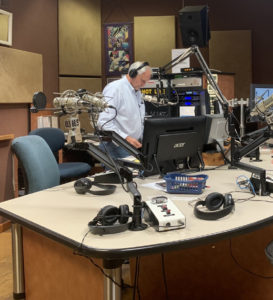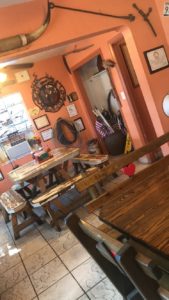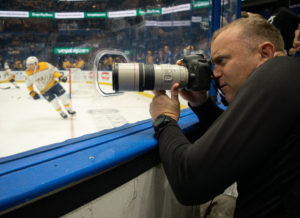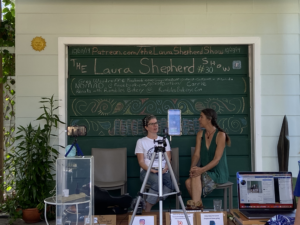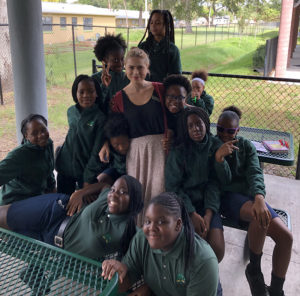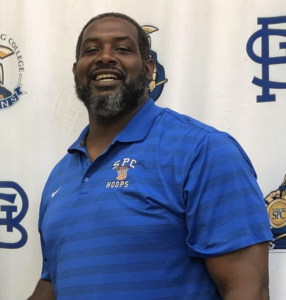With a shovel and determination, volunteer Vanessa Gray uncovers forgotten graves in long-neglected black cemetery
They offer comfort food for vegans

Baseball and a business opportunity brought Brian and Audrey Dingeman to town.
By KATLYNN MULLINS
USFSP Student Reporter
GULFPORT – When diners visit Gulfport’s newest vegan deli, they’ll likely notice two themes in the decor.
Several golden dinosaurs are scattered about, and there’s a shelf filled with dozens of bobbleheads of Tampa Bay Rays players.
The dinosaurs are gifts from customers who like the food and name of the place – Golden Dinosaurs Vegan Deli. The owners started with a few bobbleheads, and customers have added the rest.
The owners, Audrey and Brian Dingeman, got their introduction to the area when they would visit from Gainesville to watch the Rays play at Tropicana Field. They noticed there wasn’t a vegan restaurant in the St. Petersburg area, so they moved and set up shop.
The deli, which is nestled on the corner of Beach Drive and 30th Avenue S, is the town’s first restaurant offering “all-vegan comfort food made in-house,” Audrey Dingeman said.
Upon entering the restaurant, your ears are filled with punk rock music. The first thing you see is a striped wall mimicking a prism. The stripes are blue, pink, yellow, navy blue and green.
None of the light fixtures match and each wall of art has a different theme, found by Brian during his thrifting ventures.
There’s a menu board on the wall behind the register, a black background with white lettering. In front of it is a bakery case filled with dairy-free pastries.
The couple has been vegan for a “long time,” Dingeman said.
“We make comfort food for vegans who miss things they used to have,” Dingeman said.
Dingeman said there have been a lot of questions from people about what being vegan means.
“It’s not an everyday word for everyone,” she said.
Vegans consume no animal products, including dairy. They are different from vegetarians, who consume dairy products but not meat.
Vegan lifestyles vary. Some people are raw vegan, meaning they only eat raw fruits, vegetables or other food that doesn’t need to be cooked. Others don’t eat nuts or gluten.
Reasons for transitioning to veganism vary. A large reason is animal welfare and stems from a disapproval of how animals are treated in slaughterhouses.
Others transition because they believe it’s healthier, and they search for raw or gluten-free options at vegan restaurants.
“We’re vegan for the animals first and foremost,” said Dingeman. “And we’re not a healthy vegan restaurant by any means.”
They are not allergen free either, and they’re open about it.
“We do our best to prevent cross-contamination, but we use gluten, we use nuts, we use coconut and peanut butter,” Dingeman said. “We advise people with serious allergens to stay away, honestly.”
They serve mimosas on draft during brunch on the weekends, and keep the beer as local as possible.
The restaurant runs weekly specials like Cuban and Monte Cristo sandwiches. Sometimes, the item sells well and they keep it.
Others are only made for a week, or sooner if the product sells out.
“The Cuban was actually one of our first specials,” Dingeman said. “It was so popular that we immediately put it on the menu and it’s now our top seller.”

The deli also has dairy-free desserts.
The Monte Cristo didn’t become a permanent item. Normally, it’s a fried ham and cheese sandwich with syrup, Dingeman said. They made theirs from seitan, but took it a step further. They battered, deep fried it and also made blackberry jam to go with it.
When they opened the deli, it was only the two of them.
“We thought it’d be like that for a couple months, but we learned very quickly that the St. Pete area was ready for a restaurant like ours,” Dingeman said.
“So two weeks later, we hired two full-time people. We’ve grown about three times faster than we anticipated.”
The hardest things are keeping up with demand and building space to store food products. There wasn’t a walk-in freezer when they opened, so they built one.
“It’s a good problem to have,” she said.
There were about six weeks of demolition and remodeling work when they first got the place.
“We don’t have silent investors or big money hiding in a bank somewhere,” Dingeman said. “We’re doing this really grassroots. Every penny that this place makes we put into making it better.”
“We’ve been slowly swapping out equipment and getting more efficient. Things like that make the kitchen work better so we can produce more.”
Since opening, the restaurant has been inspected by the state three times and each time met inspection standards.
Twice, inspectors cited an “accumulation of black/green mold-like substance in the interior of the ice machine.” It was cleaned during the inspection both times.


